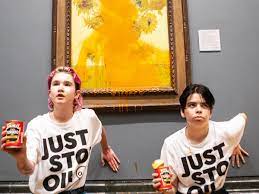Have Climate Activists Gone Too Far?

Climate activists from Just Stop Oil glue their hands underneath Van Gogh’s “Sunflowers” Photo via Antonio Olmos/The Guardian
November 30, 2022
What do we value more in our society: life or art? Numerous protests from climate change activist groups such as Just Stop Oil, Letzte Generation, and Extinction Rebellion have posed this question over the last few weeks. The first of the protests came from Just Stop Oil. The youth-led, UK-based organization sent protestors to The National Gallery art museum in London, where two members made headlines after throwing tomato soup at Vincent Van Gogh’s “Sunflowers” painting. The two activists then glued their hands to the wall underneath the painting to further their social statement. Just Stop Oil posted a video of the incident on Twitter, generating millions of views.
The painting was not damaged due to the glass protector covering it. However, the goal of the incident was not to ruin a world-famous painting; Just Stop Oil released a statement saying they “would have never considered” damaging the piece. The goal was to generate public attention and raise awareness about climate change. This has unarguably been achieved, though the attention may have elicited more negative comments than positive ones.
The Many Grievances of the Public
The critiques of this trending protest technique have only grown as organizations like Letzte Generation and Extinction Rebellion have committed similar acts of vandalism; Letzte Generation members were seen throwing mashed potatoes at Monet’s “Les Meules” painting and Extinction Rebellion members glued themselves to automobile displays in a German museum. These groups and others have tried similar protests before. Just Stop Oil members glued their hands to “The Last Supper” by Leonardo Da Vinci earlier this year. They did not generate much attention until their recent viral video.
The largest grievance critics have is that these movements may do more harm than good regarding environmental support from the media. If someone does not know much about the movement for reversing climate change and sees these incidents trending, they might have a negative view and see it as a radical movement. The protests also may turn people in support of these organizations against them due to their extreme nature. Many have likened this situation to a common phrase: one bad apple ruins the bunch. Hundreds of peaceful activist groups are overshadowed by new, younger groups taking more drastic measures to raise awareness, and the new groups may turn people away.
Others have pointed out the irony of the protestors attempting to raise awareness about a future where resources are depleted while wasting food for their protests. The protestors are trying to convey the urgency of climate change by shouting warnings about how people will be fighting for food in the decades to come. At the same time, they are throwing cans of soup and potatoes at the wall while others are already fighting for meals daily. Their method seems to contradict their message.
Art conservators are also on the opposing side of the movement. They have questioned the need to bring art into the protests when the paintings are seemingly unrelated to the urgent cause of climate change.
Those who have spoken out against these acts of vandalism are not necessarily against working to reverse Global Warming and climate change. The uniting belief of these critics is that there are better ways to raise awareness and ask questions. The organizations in question have responded quickly, pointing out that a majority of the people complaining about the protests have not cared about climate change advocates until recently.
Mission Succeeded?
There are supporters of this movement, however small the quantity, and they bring up valid points. Why does society only pay attention to these organizations when they do something extreme? Why does it take a crime for the media to care?
These questions are the exact ones the protestors say they wanted to raise with their efforts. In the aforementioned statement from Just Stop Oil, one protestor said their goal was to “get the conversation going” and to “ask the questions that matter.” The internet fame from the incidents has undoubtedly given the groups a platform to ask questions. Shouldn’t this mean they were successful? According to the National Gallery, the only physical effect of the Van Gogh vandalism was some minor damage to the frame of the painting. No one was hurt, and there are more people talking about climate change than there have been for years. Supporters of these organizations are pleased despite the onslaught of hate online.
Just Stop Oil and other similar organizations are primarily youth-led, which has caused them to accumulate more supporters from the younger generations. Many defenders of the groups see these acts as courageous and important, which is most likely a reflection of the protestors’ ages. Perhaps one good thing everyone can take away from this situation is that the younger generations are ready to fight to protect our planet and are not afraid to stand up for what they believe in.
Weddington Opinion
These incidents have widely occurred outside of the US, but opinions on the situation have come in from all over the world. We asked 30 Weddington High School students their opinion on the protesting technique of Just Stop Oil and other groups in order to gain an understanding of how our school views events in other countries.
When asked if they agree with the protests, 10 students voiced that they thought the cause was worthy but the method was too extreme or irrelevant. One student elaborated, saying, “I’m for the protection of the environment, but the whole throwing soup on paintings thing seems too crazy and illegal. I think there are better ways to [raise awareness].”
3 Weddington students claimed that they agreed with the cause and the approach. When asked to explain why, one student said, “If they hadn’t done something so big, I probably wouldn’t have seen it,” while another explained, “It’s not violent or dangerous, so [the method] could be worse and it’s for a good cause so I agree with them.”
13 students said they were neutral or unsure, either because they had not heard about it or did not care either way. 4 claimed they disagreed with the organizations’ causes because of their approach, and 0 claimed they disagreed with the cause and approach wholly.
A Daily Occurrence
Since beginning this article, we have seen climate activists perform dozens more protests, including a group gluing themselves to a dinosaur exhibit in a Berlin museum. New organizations and new incidents seem to pop up every hour, and they are not going away any time soon. 13 out of the 30 students we asked did not know enough about the situation to comment on it. However, that means that over half of the students surveyed were aware of the situation. Considering that these protests are happening primarily in western Europe and are relatively new, that is a solid awareness rate. Perhaps the critics are wrong and this rising trend of covering art with foods and fingerprints is just what the climate movement needs to generate powerful responses from world leaders.









